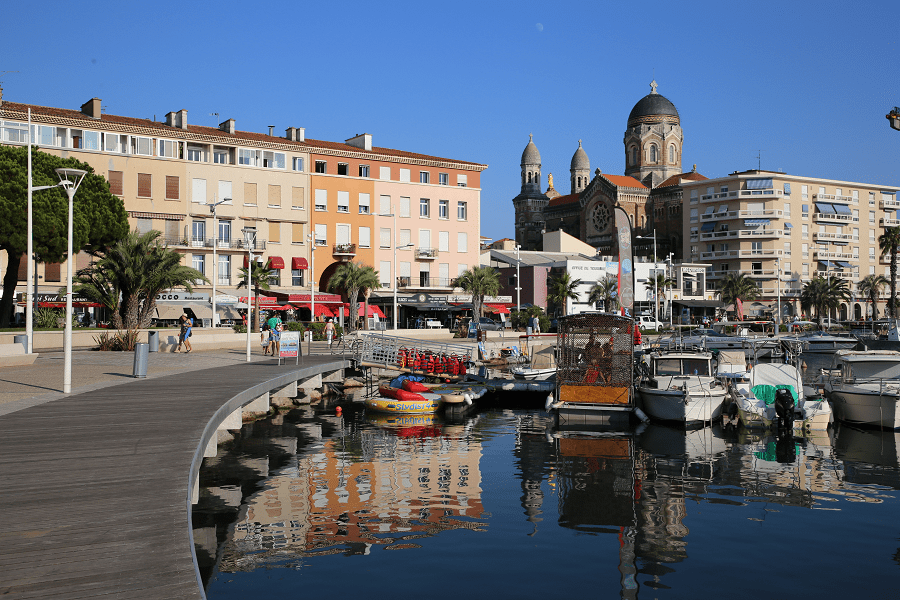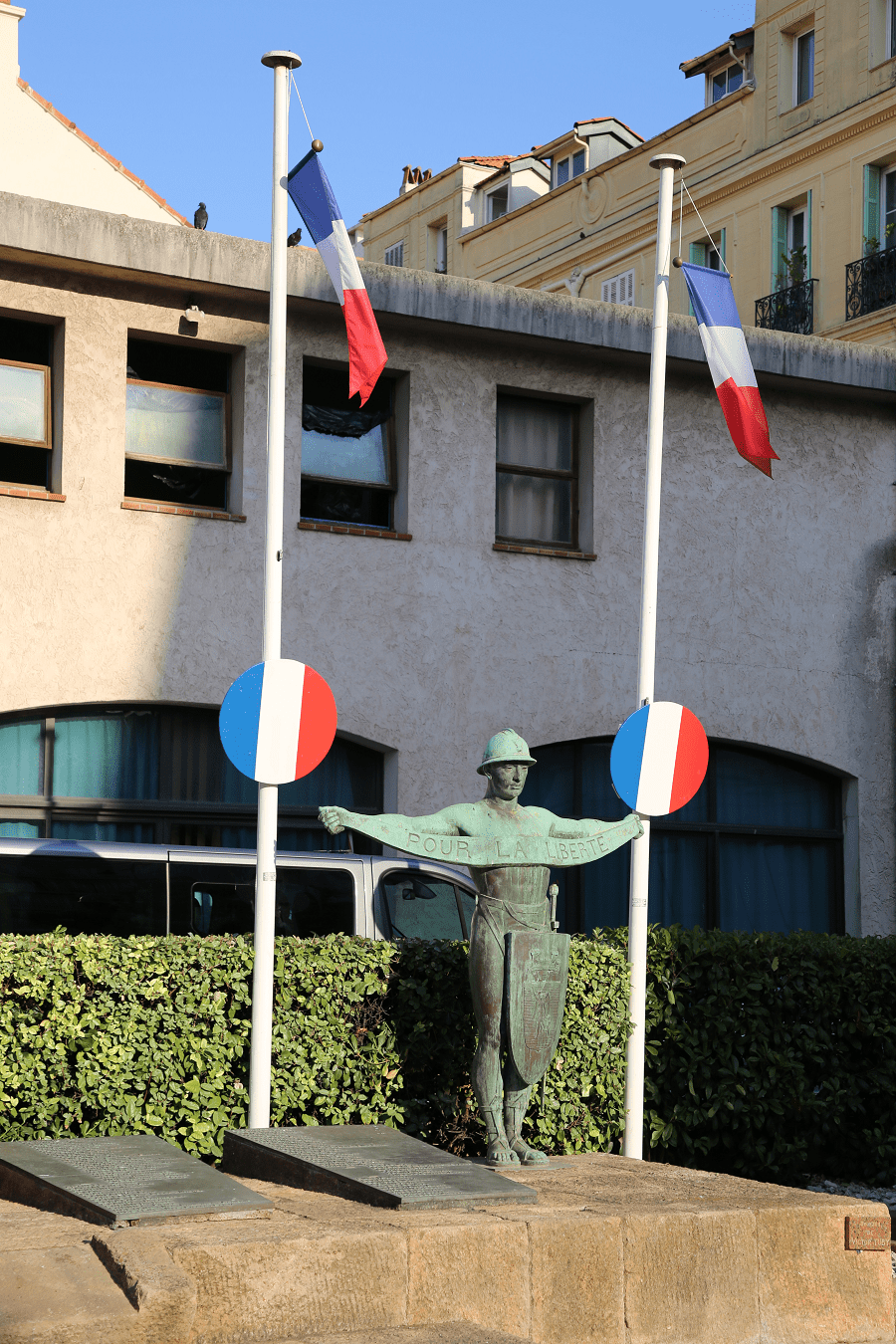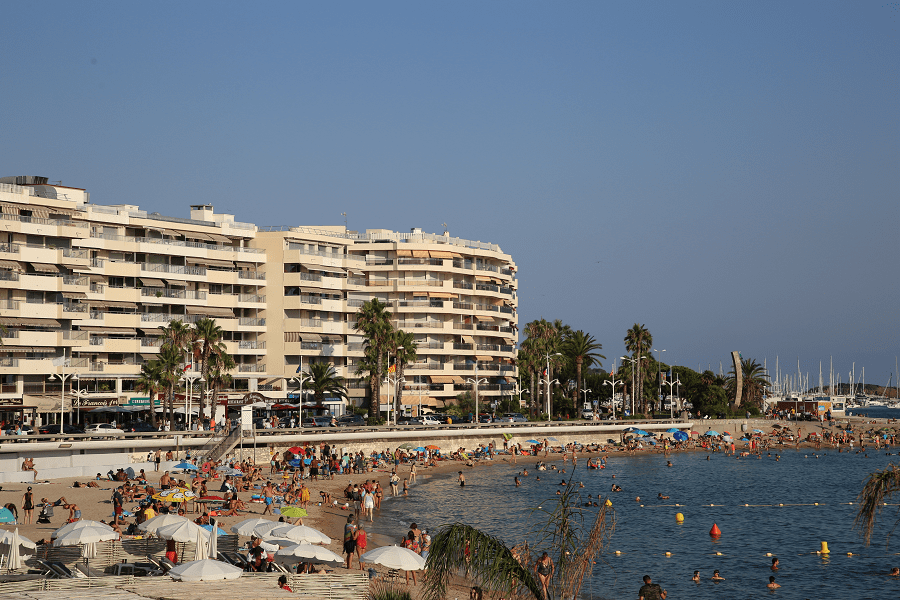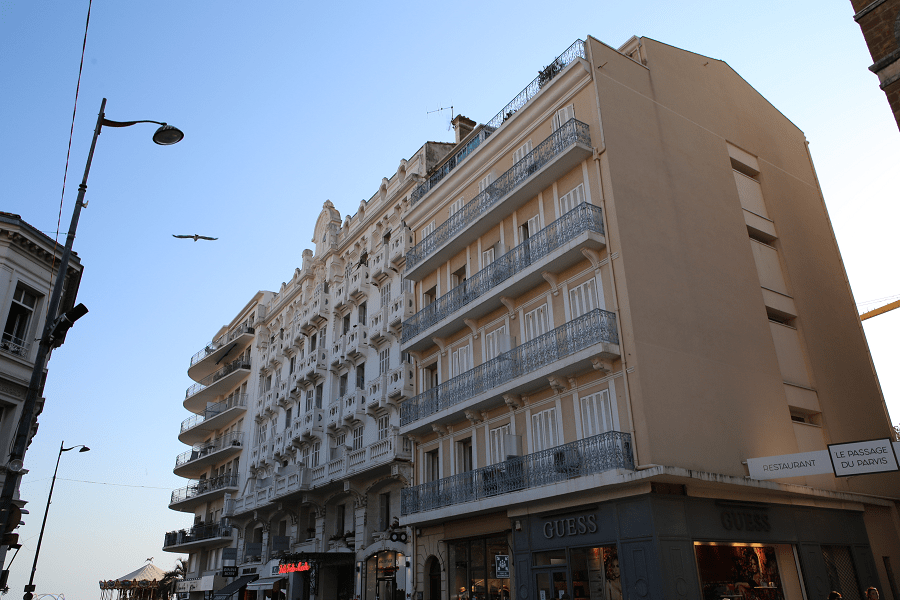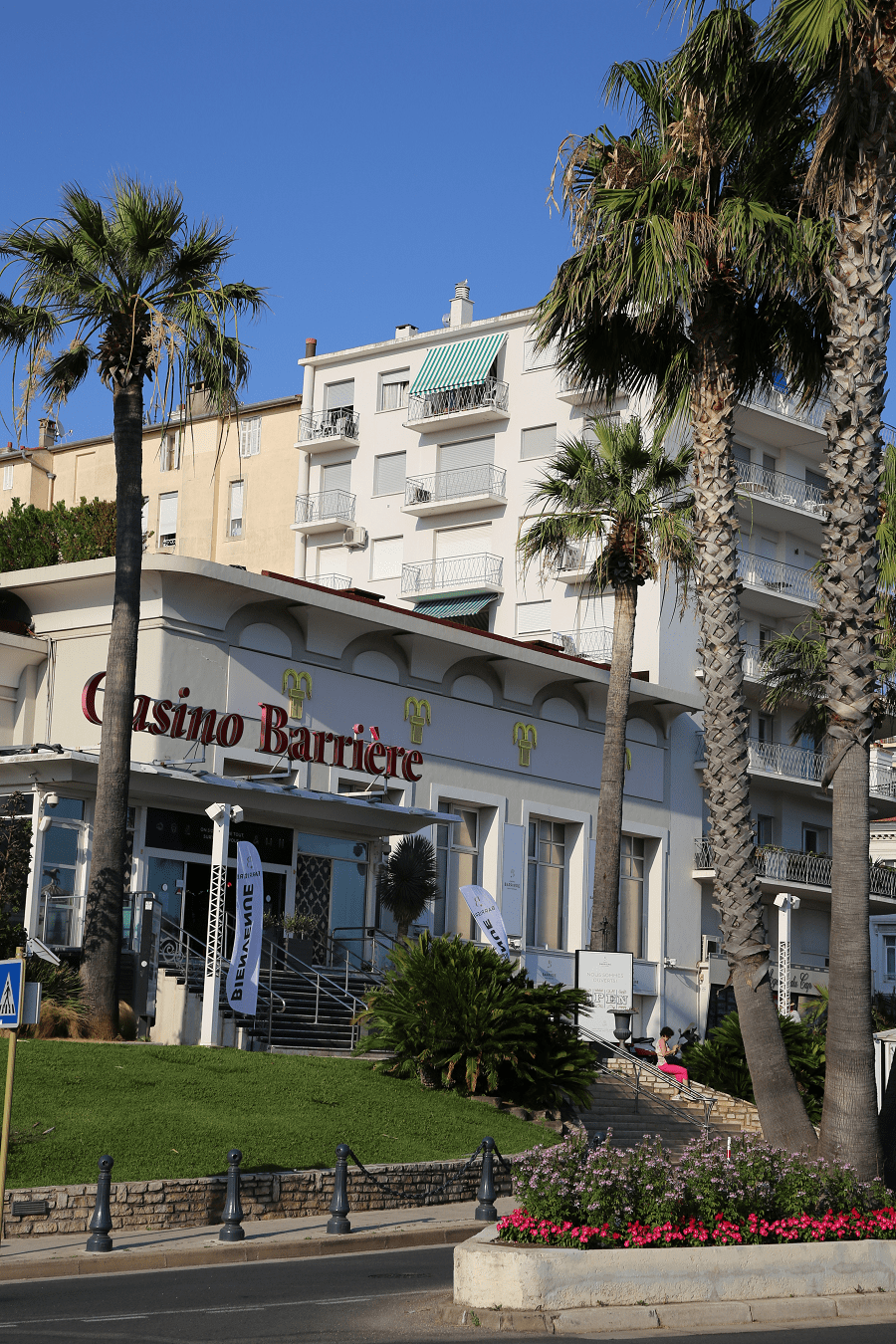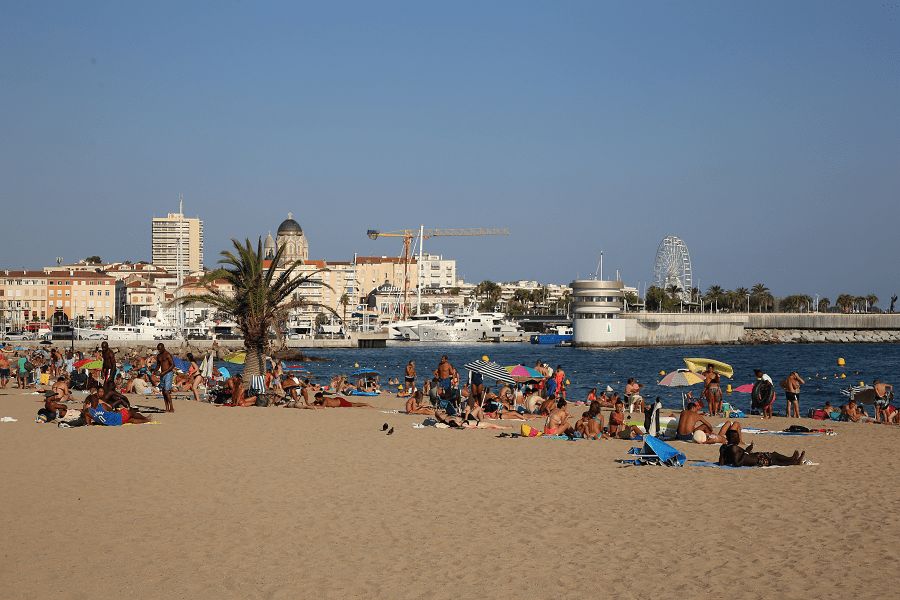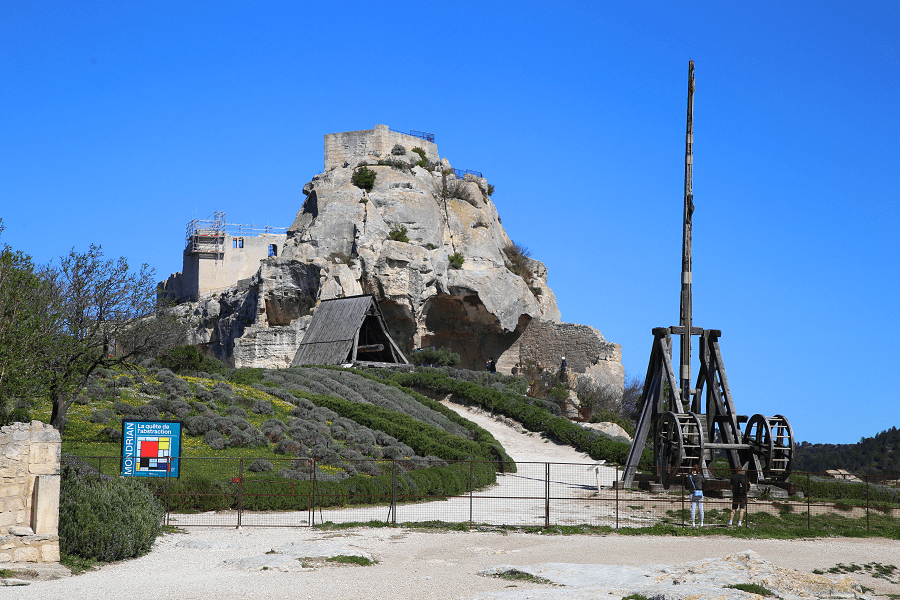Saint-Raphaël (fr. Saint-Raphaël) is a commune in the Var department in the Provence-Alpes-Côte d’Azur region in south-eastern France. Part of French Riviera.
The town was classified as a health resort on 15 September 1914. Beaches and business tourism represent an important part of the local economy.
Together with Fréjus they form an urban location known as Fréjus-Saint-Raphaël.
A seaside resort, the town’s main attraction lies in its nautical infrastructure and services. Underwater vision boat cruises are organized from the old port and the port of Agay. Pleasure boating is highly developed with five ports spread out along the coast (Old Port, Santa-Lucia, Boulouris, Poussaï and Agay) labelled France nautical station for a total of 2,229 sites.
Visitors to the town have a casino, a convention centre, six nightclubs, a museum of prehistory and underwater archaeology and various maritime activity centres for entertainment. The city also offers about ten Wi-Fi free access points.
Tourism and culture
The city has many cultural infrastructures shining on the east of the Var and has set up a municipal service dedicated to events, such as the municipal archaeological museum which presents prehistoric and Gallo-Roman collections discovered on the sites of the municipality, and objects of the Provençal tradition including the Santons of Provence.
The Palais de Congrès is the largest hall in the city, consisting of a 1,000m2 hall and an auditorium with three hundred and fifty seats, also hosts events on its agora such as salons or concerts in open sky during the summer period.
During the summer period, many events are made free by the town hall, in particular many concerts of the Jazz Festival and the chamber orchestra. Several libraries and exhibition rooms are spread over the different districts, allowing access to as many people as possible.
In recent years, cultural policy has grown steadily and many events have emerged such as the theatre festival, Documentary Film Month, Culture Mômes meetings, etc.
Fifty-six associations contribute to the cultural animation of the town.
The Archaeological Museum of Saint Raphaël, housed in the Church of the Templars, has the largest collection of amphoras in the Var.
The Louis de Funès Museum opened in July 2019.
Religious buildings
The Catholic parish of Saint-Raphaël depends on the diocese of Fréjus-Toulon. It has several places of worship including:
The Notre-Dame-de-la-Victoire basilica, boulevard Félix Martin, built in 1887 by Pierre Aublé in a neo-Byzantine style to commemorate the victory of the Holy Christian League at the battle of Lepanto on 7 October 1571 against the Ottomans of ‘Ali Pasha. The Cabourdin organ was built in the 1980s on the model of the French organ. It is the last church in France to have been elevated to the rank of minor basilica by Pope John Paul II on 14 January 2004.
The Saint-Raphaël church, rue des Templiers in the old center
The Notre-Dame du Sacré-Coeur church in Agay
The Sainte-Bernadette church in Valescure
The Church of the Sacred Heart in Boulouris
The Saint-Roch chapel in Dramont
The Notre-Dame-de-Bon-Voyage chapel on boulevard Saint-Exupéry
The chapel of Tous-les-Saints in Valescure
The Notre-Dame-de-la-Paix chapel, boulevard Alphonse Juin, aux Plaines
The Saint-Honorat chapel in Trayas
The Sainte-Thérèse chapel, boulevard Théodore Guichard at Trayas Supérieur
The chaplaincy chapel, avenue du Commandant Charcot
The chapel of the retirement home La Chênaie, boulevard Georges Clémenceau
Architectural heritage
The heritage of Saint-Raphaël is rich in the various periods of habitation and enrichment of the town.
At a place called La Cabre are the remains of a Neolithic camp. The town has several megalithic sites:
- The dolmens of Montrouge, Valbonette and Valescure (also called the dolmen of Suveret), now ruined, are included in the perimeter of the golf course.
- The Menhir d’Aire-Peyronne and the Menhirs de Veyssières are classified as historical monuments.
The Greeks stopped at Agathon on the road to Massalia, then the Romans founded Portus Agathonis connected to the Via Aurelia of which remain:
- A milestone.
- An altar.
- A necropolis.
- A quarry at a place called La Caus.
- A fragment of the Forum Julii aqueduct.
- The foundations of an important Rustica villa in the Veyssières and many wrecks of galleys loaded with amphora.
From the Middle Ages remain:
- The twelfth century church of Saint-Raphaël (of the Templars) built in a Provencal Romanesque style on a Carolingian and twelfth century construction, listed as historical monuments.
- The remains of the twelfth century ramparts, including a thirty-meter high watchtower.
- The Dramont semaphore, built in 1562, originally called the Tour d’Armont, which today belongs to the French Navy.
- The old town, the alleys, the passages with arcades and some houses are listed as historical monuments.
The Renaissance and the Ancien Régime left few traces in Saint-Raphaël, which is a fishing port and a dependency of the bishopric of Fréjus. Only the seventeenth century Notre-Dame chapels and the eighteenth century de la Miséricorde chapels in neoclassical style and the Château d’Agay from 1635 remain. In 1799 a pyramid was built on the port to commemorate the landing of Napoleon Bonaparte on his return from the Egyptian campaign.
The tourist boom due to Alphonse Karr and the mayor Félix Martin allowed the construction of the casino in 1881, the Protestant temple in 1882, the Notre-Dame-de-la-Victoire basilica in 1887 in a neo-Byzantine style.
Among other interesting places: the Villa Magali in the Beaux-Arts style listed as historical monuments, the Tuileries Palace brought back by Léon Carvalho, the Mauresque Villa built in 1860 by the architect Pierre Chapoulard, the Villa Notre Dame (former residence of Clémentine de Belgium), the villa La Péguière (built in 1880 by Edouard Siegfried), the Continental and Excelsior hotels opened at the beginning of the twentieth century and renovated in 1993 and numerous villas in the Beaux-Arts, Art Nouveau and Art Deco styles (often designed by architect Pierre Aublé).
Cuisine and restaurants
You can find mostly Mediterranean cuisine in the city. The best restaurants are on the sea bank.
Shopping
The city can’t boast good shopping. The best shopping area nearby is Cannes city.
Beaches
Plage de la Péguière, Plage des Fournas, Plage de Boulouris, Plage Abel Baliff, Plage d’Arène Grosse, Plage d’Aiguë Bonne, Plage du Camp Long (Tiki Plage). All available for kids.
Transport and how to get to?
Saint-Raphaël is accessible by car, via the A8 (E 80) at the Fréjus / Saint-Raphaël exit. The N 7 (now RD N7 in the Var) acts as the border to the north with the town of Fréjus. The old N 98 (now RD 98) runs along the entire coast of Saint-Raphaël under the name of Corniche d’Or and continues beyond to join Roquebrune-Cap-Martin to the east and Toulon-la Valette-du-Var to the west.
By train, Saint-Raphaël-Valescure station is served by TGV and iDTGV from Paris-Gare de Lyon to Nice, Intercités from Paris-Gare de Paris-Austerlitz to Nice, lines 03 and 06 from TER Provence-Alpes-Côte d’Azur from Marseille-Gare Saint-Charles to Nice. In addition, the TER network is also accessible at Boulouris-sur-Mer, Dramont, Agay, Anthéor-Cap-Roux and Trayas stations.
By bus, the bus station lines 2601, 2602, 3601, 3602, 3603, 7601 and 7702 of the departmental network, lines 1bis, 3, 4, 5, 6, 7, 8, 10, 11, 12 and 14 of the network intercommunal AggloBus Fréjus / Saint-Raphaël, and can reach Nice-Côte d’Azur airport in 1 hour 15 minutes by CPF group coaches (line 3003).
Cannes – Mandelieu airport is 20 km away, Nice-Côte d’Azur airport – 55 km, and La Môle – Saint-Tropez airport – 34 km away.
The “Bateaux de Saint-Raphaël” shuttles provide fast connections to Saint-Aygulf, Port-Fréjus, the Lérins islands, Saint-Tropez and Cannes.
Shortest distance by car:
From Menton (tolls): 1 h 20 min (97.4 km) via A8
From Monaco (tolls): 1 h 16 min (89.6 km) via A8
From Beaulieu-sur-Mer (tolls): 1 h 21 min (84.2 km) via A8
From Villefranche-sur-Mer (tolls): 1 h 21 min (84.1 km) via A8
From Nice (tolls): 1 h 6 min (74.4 km) via A8
From Cagnes-sur-Mer (tolls): 47 min (55.3 km) via A8
From Antibes (tolls): 50 min (52.7 km) via A8
From Cannes (tolls): 50 min (52.7 km) via A8
From Mandelieu-La Napoule (tolls): 28 min (31.0 km) via A8
From Fréjus: 11 min (3.9 km) via Avenue de Lattre de Tassigny
From Sainte-Maxime: 36 min (25.0 km) via D8
From Saint-Tropez (tolls): 53 min (39.2 km) via D8
From Cavalaire-sur-Mer (tolls): 1 h 2 min (45.4 km) via D559 and D8
From Toulon (tolls): 1 h 7 min (93.1 km) via A57 and A8
From Aix-en-Provence (tolls):
From Nîmes (tolls): 1 h 21 min (119 km) via A8
From Marseille (tolls): 1 h 37 min (143 km) via A8
From Avignon (tolls): 2 h 3 min (204 km) via A7 and A8
From Montpellier (tolls): 2 h 51 min (270 km) via A8
From Sète (tolls): 2 h 58 min (299 km) via A8
From Agde (tolls): 3 h 12 min (323 km) via A9 and A8
From Pézenas (tolls): 3 h 13 min (325 km) via A9 and A8
From Béziers (tolls): 3 h 21 min (335 km) via A9 and A8
From Perpignan (tolls): 4 h 2 min (419 km) via A9 and A8
From Argelès-sur-Mer (tolls): 4 h 21 min (446 km) via A9 and A8
From Collioure (tolls): 4 h 26 min (453 km) via A9 and A8
From Narbonne (tolls): 3 h 30 min (358 km) via A9 and A8
From La Baule-Escoublac (tolls): 11 h 4 min (1,163 km) via A7
From Saint-Nazaire (tolls): 11 h 1 min (1,148 km) via A7
From Saumur (tolls): 9 h 11 min (958 km) via A7
From Nantes (tolls): 9 h 48 min (1,087 km) via A62
From Les Sables-d’Olonne (tolls): 10 h 14 min (1,076 km) via A62
From Cognac (tolls): 8 h 26 min (863 km) via A62
From Angoulême (tolls): 8 h 25 min (861 km) via A62
From Eauze (tolls): 6 h 27 min (635 km) via A9
From La Rochelle (tolls): 8 h 56 min (924 km) via A62
From Rochefort (tolls): 8 h 31 min (896 km) via A62
From Saintes (tolls): 8 h 11 min (860 km) via A62
From Arcachon (tolls): 7 h 54 min (800 km) via A62
From Royan (tolls): 8 h 34 min (864 km) via A62
From Biarritz (tolls): 7 h 38 min (807 km) via A64
From Saint-Jean-de-Luz (tolls): 7 h 43 min (813 km) via A64
From Bayonne (tolls): 7 h 29 min (794 km) via A64
From Dax (tolls): 7 h 29 min (773 km) via A64
From Lourdes (tolls): 6 h 27 min (673 km) via A64
From Pau (tolls): 6 h 41 min (690 km) via A64
From Périgueux (tolls): 7 h 32 min (775 km) via A20
From Bordeaux (tolls): 7 h 11 min (747 km) via A62
From Toulouse (tolls): 4 h 52 min (505 km) via A61, A9 and A8
From Carcassonne (tolls): 4 h 2 min (414 km) via A9 and A8
From Andorra (tolls): 6 h 41 min (595 km) via A9
Main information
Area: 90 sq. km
Population: 35 100
Languages: French
Currency: euro
Visa: Schengen
Time: Central European UTC +1
Coordinates: 43°25′31″N 6°46′06″E
See here best sea and ocean resorts of France and Spain (223 objects)



